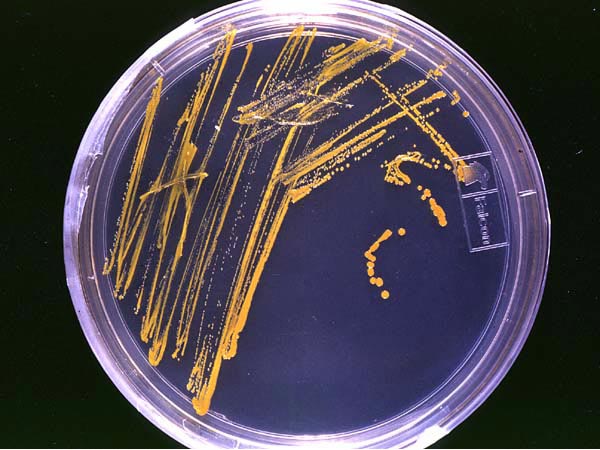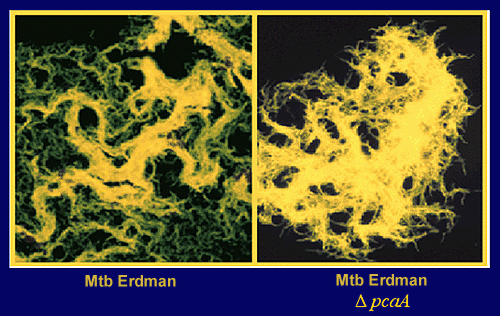Visiting Bill Jacobs’ lab is no easy feat: You have to ditch your notebook, pen, laptop, and whatever else you’ve been lugging around, zip into a Tyvek jumpsuit, fasten latex gloves over your hands, secure a respirator mask and hairnet—and then don a second pair of gloves for good measure.
Jacobs’ lab may not contain Ebola or Anthrax, but it does house a frighteningly virulent infectious disease: tuberculosis (TB). The laboratory, a Biosafety Level 3 facility located on the fifth floor of the Michael F. Price Center for Genetic and Translational Medicine, is located at the Albert Einstein College of Medicine in the Bronx. It is from here, overlooking an old TB sanatorium, that Jacobs and his team are working to wipe out the dangerous bacteria once and for all, any way they can.
This has been a decades-long pursuit for Jacobs, an AAAS Fellow and professor of microbiology and immunology and of genetics at Einstein. Since 1985, he has studied the tiny rod-shaped organism,Mycobacterium tuberculosis (M. tuberculosis for short), that causes the infectious lung disease, and in that time, it has proved itself a masterful opponent. With most of its 4,400 genes constantly evolving to ensure its survival, M. tuberculosis has poked holes in the leading vaccine, evaded antibiotic drugs that once seemed to be certain cures, and kept TB as one of the 10 leading causes of death around the world. Yet Jacobs—also a veteran Howard Hughes Medical Institute investigator—has moved forward undeterred in his quest to devise a better treatment and prevention for TB.
“If you can imagine it, it’s out there,” Jacobs likes to tell his students. “The secret is figuring out a clever way of finding it.”
He is referring to a vision that bacterial geneticists like him share: to isolate and analyze each gene of an organism in order to gain insight into the properties of the whole. But Jacobs easily could be talking about his aim to eliminate TB. He moves towards both of these goals with the pragmatism of a logician (not surprising since this Pittsburgh native was a math major in college) and the resourcefulness of an inventor (where others see a fistful of dirt, he has found a key to unlocking genetic secrets), systematically and creatively analyzing the genetic underpinnings of M. tuberculosis. And he does this despite a genetic eye disease that severely limits his peripheral vision and now requires him to use a walking stick. The impairment has quietly influenced his focus on TB, a disease that most often afflicts the poor and disadvantaged: “I guess I’ve always been sympathetic to the underdog,” Jacobs says.
In 2010, 1.4 million people died of tuberculosis, according to the World Health Organization—and 95 percent of them lived in the developing world. Billions more are estimated to have latent TB infection, which surfaces only when a person’s immune system can no longer keep the bacteria in check. TB is particularly virulent among those infected with HIV, and nowhere is that virus more prevalent than in sub-Saharan Africa, where multidrug resistant and extensively drug-resistant TB strains have created a public health epidemic. A combination of drugs may be able to treat 99.9 percent of TB in a patient within four days, says Jacobs, but it can take up to six months of continued treatment to treat the remaining 0.1 percent—if the TB can be killed at all.
In the 27 years Jacobs has spent studying M. tuberculosis, he has advanced both genetics and TB research to unravel the nature of that 0.1 percent—“the persistors,” as he likes to call them. He has met particular success through his work with mycobacteriophages (phages), or special viruses that infect mycobacteria likeM. tuberculosis. Jacobs has engineered phages to pierce through the stubbornly waxy coating of M. tuberculosis and insert mycobacterial DNA to knock out the bacterium’s genes. (Jacobs’ 1987 discovery, called a shuttle plasmid, is now a widely used technique in genetics.) He has used phages to create a rapid diagnostic test for drug-susceptible TB. And he has isolated a mutant strain of a related mycobacterium, the fast-growing Mycobacterium smegmatis, that is particularly ripe for genetic experimentation. The highly transformable strain, mc(2)155, is named with a nod to Albert Einstein and can be found in labs around the world.
But to Jacobs, equally important as his career successes has been his role teaching future generations about the importance of basic research. For the last 20 summers, Jacobs has run a successful program for high schoolers called “No Phage Left Behind,” where young scientists learn to identify and sequence new phages. (It’s been so successful that the Howard Hughes Medical Institute now runs a related national program for college students.) He also travels two to three times a year to South Africa, where for the last five years he has led master’s students on similar phage-finding excursions.
It’s in South Africa, where HIV prevalence has been documented as high as 30 percent, that Jacobs is tackling the most pernicious outbreak of tuberculosis. This fall, his work in the region will deepen with the opening of the KwaZulu-Natal Research Institute for Tuberculosis and HIV in Durban. There, in a $40 million facility constructed by the Howard Hughes Medical Institute and the University of KwaZulu-Natal, he will collaborate with researchers studying the interaction between bacteria and virus in a replica of his state-of-the-art Bronx lab.
It’s through Jacobs’ continued work with M. tuberculosis that he predicts the ultimate TB killer will emerge, one that will prevent the disease from developing in the first place—a more safe and efficacious vaccine than the current standard, bacille Calmette–Guérin (BCG). “The one thing that’s going to change the history of the world is getting a vaccine out there that works,” he says.
A proverb, one of many inspirational quotes Jacobs likes to recite and post by the door to his office, provides Jacobs with particular drive: “Where there is no vision, the people perish.” Finding a vaccine is a vision he’s had for some time, and one that he will not give up.
All I care about is death—killing TB,” he says with a grin.
Author: Freelance Writer Marissa Miley

